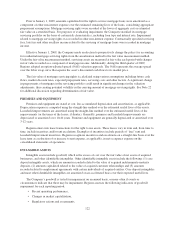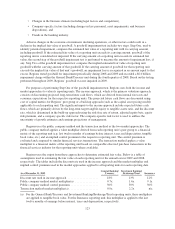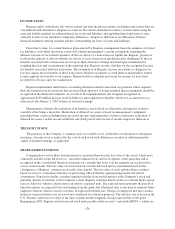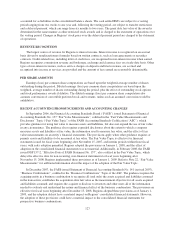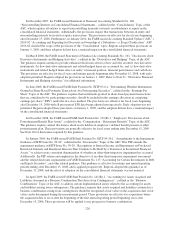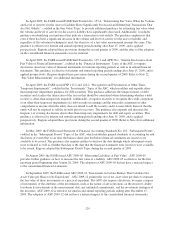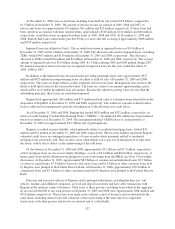Regions Bank 2009 Annual Report Download - page 143
Download and view the complete annual report
Please find page 143 of the 2009 Regions Bank annual report below. You can navigate through the pages in the report by either clicking on the pages listed below, or by using the keyword search tool below to find specific information within the annual report.In April 2009, the FASB issued FASB Staff Position No. 157-4, “Determining Fair Value When the Volume
and Level of Activity for the Asset or Liability Have Significantly Decreased and Identifying Transactions That
Are Not Orderly”, codified in the Fair Value Topic, to provide additional guidance for estimating fair value when
the volume and level of activity for the asset or liability have significantly decreased. Additionally, it includes
guidance on identifying circumstances that indicate a transaction is not orderly. The guidance emphasizes that
even if there has been a significant decrease in the volume and level of activity for the asset or liability and
regardless of the valuation technique(s) used, the objective of a fair value measurement remains the same. This
guidance is effective for interim and annual reporting periods ending after June 15, 2009, and is applied
prospectively. Regions adopted these provisions during the second quarter of 2009, and the effect of the adoption
on the consolidated financial statements was not material.
In April 2009, the FASB issued FASB Staff Position No. 107-1 and APB 28-1, “Interim Disclosures about
Fair Value of Financial Instruments”, codified in the “Financial Instruments” Topic of the ASC, to require
disclosures about fair value of financial instruments for interim reporting periods as well as in annual financial
statements. This guidance is effective for interim and annual reporting periods ending after June 15, 2009, and is
applied prospectively. Regions adopted these provisions during the second quarter of 2009. Refer to Note 22,
“Fair Value Measurements” for additional information.
In April 2009, the FASB issued FSP 115-2 and 124-2, “Recognition and Presentation of Other-Than-
Temporary Impairments”, codified in the “Investments” Topic of the ASC, which modifies and expands other-
than-temporary impairment guidance for debt securities. This guidance addresses the unique features of debt
securities and clarifies the interaction of the factors that should be considered when determining whether a debt
security is other-than-temporarily impaired. Additionally, it requires an entity to recognize the credit component
of an other-than-temporary impairment of a debt security in earnings and the noncredit component in other
comprehensive income when the entity does not intend to sell the security and it is more likely than not that the
entity will not be required to sell the security prior to recovery. The guidance also expands and increases the
frequency of existing disclosures about other-than-temporary impairments for debt and equity securities. This
guidance is effective for interim and annual reporting periods ending after June 15, 2009, and is applied
prospectively. Regions adopted these provisions during the second quarter of 2009. Refer to Note 4 for additional
information.
In May 2009, the FASB issued Statement of Financial Accounting Standards No. 165, “Subsequent Events”,
codified in the “Subsequent Events” Topic of the ASC, which establishes general standards of accounting for and
disclosure of events that occur after the balance sheet date but before financial statements are issued or are
available to be issued. This guidance also requires entities to disclose the date through which subsequent events
were evaluated as well as whether that date is the date that the financial statements were issued or were available
to be issued. Regions adopted the Subsequent Events Topic during the second quarter of 2009.
In August 2009, the FASB issued ASU 2009-05 “Measuring Liabilities at Fair Value”. ASU 2009-05
provides further guidance on how to measure the fair value of a liability. ASU 2009-05 is effective for the first
reporting period beginning after August 26, 2009. The adoption of ASU 2009-05 did not have a material impact
to the consolidated financial statements.
In September 2009, the FASB issued ASU 2009-12 “Investments in Certain Entities That Calculate Net
Asset Value per Share (or Its Equivalent)”. ASU 2009-12 permits the use of net asset value per share to estimate
the fair value of these investments as a practical expedient. The ASU also requires disclosure, by major category
of investment, of the attributes of the investments, such as the nature of any restrictions on the investor's ability
to redeem its investments at the measurement date, any unfunded commitments, and the investment strategies of
the investees. ASU 2009-12 is effective for interim and annual reporting periods ending after December 15,
2009. The adoption of ASU 2009-12 did not have a material impact to the consolidated financial statements.
129





